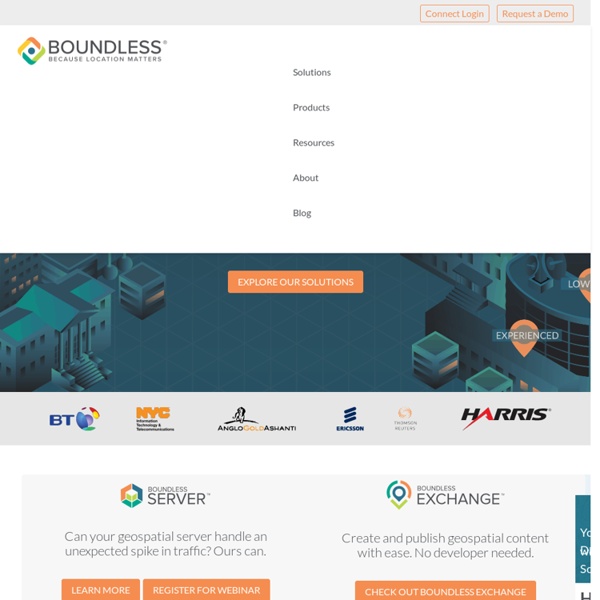



Tässä.fi+ Maps Web-Based Mapping In Your HDA With the maps app you can add some web-based mapping to your HDA! It uses the popular open source OpenLayers web mapping framework. Installation This application can be eaily installed using the (currently in Alpha testing) web-apps tab in your HDA setup. Go to the Web Apps Setup Tab and define a new app. Note that Root Path that it creates automatically for you. Downloading the Application Package Download the compressed package from spatialguru.com (v2, 421Kb). There are only four basic steps. Somewhat outdated images illustrate the process below. [Note the image shows the file saved as maps.tgz.1, but you can ignore that :) ] The tar command will unpack a bunch of files. Launch the Maps! ENJOY!
OpenPlans | Helping cities work better. Datadotgc.ca - A citizen-led beta for government data | datadotgc.ca kantaa valitsemassa Nykyään ensisijainen tapa tallentaa paikkatietoja on relaatiotietokanta. Tiedostopohjaiset ratkaisut ovat hyviä tietojen siirtämiseen, mutta varsinainen paikkatietojen käsittely tehdään pääsääntöisesti tietokantaan tallennetuista paikkatiedoista. Tietokantaratkaisujakin on nähty monenlaisia matkan varrella: relaatiopohjaiset tietokannat ovat kuitenkin yleisyytensä kautta muodostuneet defacto-ratkaisuksi. Oikean relaatiotietokannan valinta on sitten hieman monimutkaisempi ongelma. Jos on mahdollisuus vapaasti valita paikkatietojen tallentamiseen relaatiotietokanta, niin on hyvä tutustua tähän blog-kirjoitukseen: Compare SQL Server 2008 R2, Oracle 11G R2, PostgreSQL/PostGIS 1.5 Spatial Features. Paikkatietokannan valintaa ei voi eriyttää sovelluspalvelimista ja työasemasovelluksista. Tykkää tästä: Tykkää Lataa...
Online Mind Mapping and Brainstorming - MindMeister Saving Millions: Why Cities should Fork the Kuali Foundation For those interested in my writing on open source, municipal issues and technology, I want to be blunt: I consider this to be one of the most important posts I’ll write this year. A few months ago I wrote an article and blog post about “Muniforge,” an idea based on a speech I’d given at a conference in 2009 in which I advocated that cities with common needs should band together and co-develop software to reduce procurement costs and better meet requirements. I continued to believe in the idea, but have recognized that cultural barriers would likely mean it would be difficult to realize. Last month that all changed. The result? In other words for the past 5 years over 35 universities in the United States, Canada, Australia and South Africa have been successfully co-developing software. For cities everywhere interested in controlling spending or reducing costs, this should be an earth shattering revelation – a wake up call – for several reasons: The Kuali Foundation homepage
Compare SQL Server 2008 R2, Oracle 11G R2, PostgreSQL/PostGIS 1.5 Spatial Features In our prior compare -- we compared PostgresQL 8.3/PostGIS 1.3-1.4, SQL Server 2008 and MySQL 5+ (now owned by Oracle). Many people would have preferred seeing Oracle or IBM DB2 in the mix since few use MySQL seriously for spatial work. So by popular demand we are replacing our compare of MySQL with that of Oracle. A couple of exciting things have happened since that last comparison. PostGIS released PostGIS 1.5 which introduced native geodetic support in the form of a new type called geography. In this new comparison, we'll be comparing the geodetic support offered by these three commendable spatially enabled DBMS as well as standard OGC planar geometry support. In PostgreSQL/PostGIS and SQL Server you get both geometry and geography full support as well as all the functions that work with them at no extra cost but as two separate data types. Full Disclosure -- Regina is on the PostGIS project steering committee. Why would you ever want to pick more than one. Now on with the show.